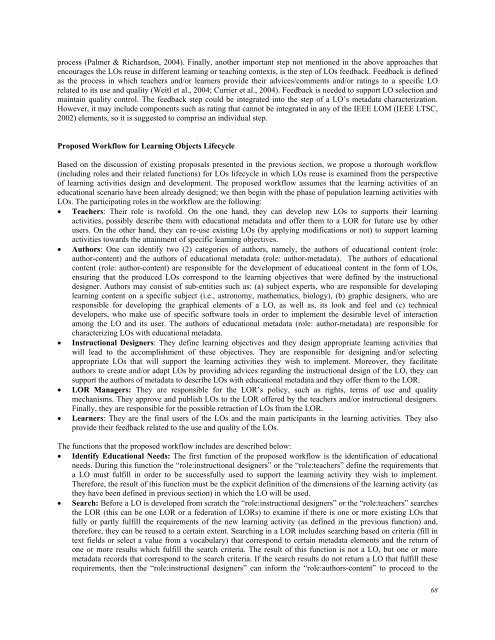October 2011 Volume 14 Number 4 - Educational Technology ...
October 2011 Volume 14 Number 4 - Educational Technology ...
October 2011 Volume 14 Number 4 - Educational Technology ...
Create successful ePaper yourself
Turn your PDF publications into a flip-book with our unique Google optimized e-Paper software.
process (Palmer & Richardson, 2004). Finally, another important step not mentioned in the above approaches that<br />
encourages the LOs reuse in different learning or teaching contexts, is the step of LOs feedback. Feedback is defined<br />
as the process in which teachers and/or learners provide their advices/comments and/or ratings to a specific LO<br />
related to its use and quality (Weitl et al., 2004; Currier et al., 2004). Feedback is needed to support LO selection and<br />
maintain quality control. The feedback step could be integrated into the step of a LO’s metadata characterization.<br />
However, it may include components such as rating that cannot be integrated in any of the IEEE LOM (IEEE LTSC,<br />
2002) elements, so it is suggested to comprise an individual step.<br />
Proposed Workflow for Learning Objects Lifecycle<br />
Based on the discussion of existing proposals presented in the previous section, we propose a thorough workflow<br />
(including roles and their related functions) for LOs lifecycle in which LOs reuse is examined from the perspective<br />
of learning activities design and development. The proposed workflow assumes that the learning activities of an<br />
educational scenario have been already designed; we then begin with the phase of population learning activities with<br />
LOs. The participating roles in the workflow are the following:<br />
Teachers: Their role is twofold. On the one hand, they can develop new LOs to supports their learning<br />
activities, possibly describe them with educational metadata and offer them to a LOR for future use by other<br />
users. On the other hand, they can re-use existing LOs (by applying modifications or not) to support learning<br />
activities towards the attainment of specific learning objectives.<br />
Authors: One can identify two (2) categories of authors, namely, the authors of educational content (role:<br />
author-content) and the authors of educational metadata (role: author-metadata). The authors of educational<br />
content (role: author-content) are responsible for the development of educational content in the form of LOs,<br />
ensuring that the produced LOs correspond to the learning objectives that were defined by the instructional<br />
designer. Authors may consist of sub-entities such as: (a) subject experts, who are responsible for developing<br />
learning content on a specific subject (i.e., astronomy, mathematics, biology), (b) graphic designers, who are<br />
responsible for developing the graphical elements of a LO, as well as, its look and feel and (c) technical<br />
developers, who make use of specific software tools in order to implement the desirable level of interaction<br />
among the LO and its user. The authors of educational metadata (role: author-metadata) are responsible for<br />
characterizing LOs with educational metadata.<br />
Instructional Designers: They define learning objectives and they design appropriate learning activities that<br />
will lead to the accomplishment of these objectives. They are responsible for designing and/or selecting<br />
appropriate LOs that will support the learning activities they wish to implement. Moreover, they facilitate<br />
authors to create and/or adapt LOs by providing advices regarding the instructional design of the LO, they can<br />
support the authors of metadata to describe LOs with educational metadata and they offer them to the LOR.<br />
LOR Managers: They are responsible for the LOR’s policy, such as rights, terms of use and quality<br />
mechanisms. They approve and publish LOs to the LOR offered by the teachers and/or instructional designers.<br />
Finally, they are responsible for the possible retraction of LOs from the LOR.<br />
Learners: They are the final users of the LOs and the main participants in the learning activities. They also<br />
provide their feedback related to the use and quality of the LOs.<br />
The functions that the proposed workflow includes are described below:<br />
Identify <strong>Educational</strong> Needs: The first function of the proposed workflow is the identification of educational<br />
needs. During this function the “role:instructional designers” or the “role:teachers” define the requirements that<br />
a LO must fulfill in order to be successfully used to support the learning activity they wish to implement.<br />
Therefore, the result of this function must be the explicit definition of the dimensions of the learning activity (as<br />
they have been defined in previous section) in which the LO will be used.<br />
Search: Before a LO is developed from scratch the “role:instructional designers” or the “role:teachers” searches<br />
the LOR (this can be one LOR or a federation of LORs) to examine if there is one or more existing LOs that<br />
fully or partly fulfill the requirements of the new learning activity (as defined in the previous function) and,<br />
therefore, they can be reused to a certain extent. Searching in a LOR includes searching based on criteria (fill in<br />
text fields or select a value from a vocabulary) that correspond to certain metadata elements and the return of<br />
one or more results which fulfill the search criteria. The result of this function is not a LO, but one or more<br />
metadata records that correspond to the search criteria. If the search results do not return a LO that fulfill these<br />
requirements, then the “role:instructional designers” can inform the “role:authors-content” to proceed to the<br />
68

















